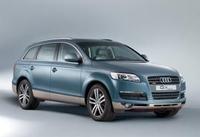Audi Q7 hybrid unveiled at Frankfurt
 A closely guarded Audi secret has become public knowledge this week at the official unveiling of the new Audi Q7 SUV in Frankfurt, where a futuristic petrol and electric hybrid version of the seven-seat luxury all-terrain vehicle took the world’s media by surprise. Public reaction will be a key factor in determining the future for the Q7 hybrid, but this production-ready concept could become a reality by 2008.
A closely guarded Audi secret has become public knowledge this week at the official unveiling of the new Audi Q7 SUV in Frankfurt, where a futuristic petrol and electric hybrid version of the seven-seat luxury all-terrain vehicle took the world’s media by surprise. Public reaction will be a key factor in determining the future for the Q7 hybrid, but this production-ready concept could become a reality by 2008. The Q7 hybrid concept study combines a 4.2-litre V8 petrol engine incorporating economy-boosting FSI injection technology with an electric motor that helps to minimise emissions and to reduce overall fuel consumption by almost 13 per cent compared with a conventional equivalent.
Unlike some supposed cars of the future, this extra special Q7 remains firmly planted in reality where performance is concerned. Acceleration from rest to 62mph can be covered in just 6.8 seconds, and the key fifth gear overtaking increment between 50mph and 75mph takes exactly 7 seconds. Thanks to the combination of petrol FSI and electric technologies, the 2,410-kilogramme Q7 is also able to cover up to 23.5mpg – a considerable improvement over conventional V8-powered SUVs.
Located between the engine and the six-speed automatic transmission’s torque converter, the motor draws its power from a nickel-metal hydride (NiMH) battery system concealed beneath the luggage compartment floor. Neither component intrudes on cabin space, and the complete system adds only 140kg to the total weight of the Q7 - a modest 7 per cent increase.
A separating clutch links the FSI engine and the electric motor, and enables the two power sources to operate individually or in unison, meaning that at any one time the Q7 hybrid can be propelled by the combustion engine or electric motor alone, or a combination of the two.
‘Recuperation’ phase
The electric motor can operate alone - in virtual silence - at speeds of up to 18mph, reducing noise levels and emissions in built-up areas and dense urban traffic. While doing so, it can also feed the extra kinetic energy produced during braking and engine overrunning back into the system to recharge the battery. During this ‘recuperation’ phase the unit switches its function imperceptibly and in a fraction of a second to act as a generator. When battery capacity drops to a minimum, the combustion engine also cuts in seamlessly to recharge it.
The eight-cylinder petrol engine featuring FSI direct petrol injection delivers 350PS and a maximum torque output of 440Nm. If the accelerator pedal is fully depressed, electric and V8 power are combined and up to 44PS and 200Nm of torque are added to these totals, ensuring that performance is actually stronger than the ‘standard’ V8 petrol Q7. The sprint from 0-62mph is 0.6 seconds quicker, and the time taken to cover the important 50mph-75mph in-gear increment is reduced by two seconds.
If the new Q7 hybrid is stationary for more than three seconds, or is coasting without the accelerator pedal depressed, the combustion engine is automatically switched off to conserve fuel. Releasing the foot brake and depressing the accelerator restarts it. The electric motor assumes the role of the starter-alternator unit, resulting in a quiet, smooth and extra-quick starting process.
Solar cells
The concept study also harnesses the power of the sun. Solar cells integrated into the open sky system – the SUV's large-format glass sunroof – allow the ventilation and air conditioning systems to be operated when the vehicle is parked and switched off. The driver can also now activate these systems remotely a few minutes before starting a journey so that the cabin environment is pleasantly chilled right from the word go - a valuable boost to comfort on hot summer days. Part of the battery capacity of the hybrid drive system is used in order to achieve this.
Audi remains the only European manufacturer to have brought a production hybrid vehicle to market. The Audi duo - an A4 Avant powered by a 90PS 1.9-litre TDI engine and an electric motor that added a further 29PS – was launched in 1997, but experimental vehicles gradually evolving this technology have been developed by Audi since 1989.




